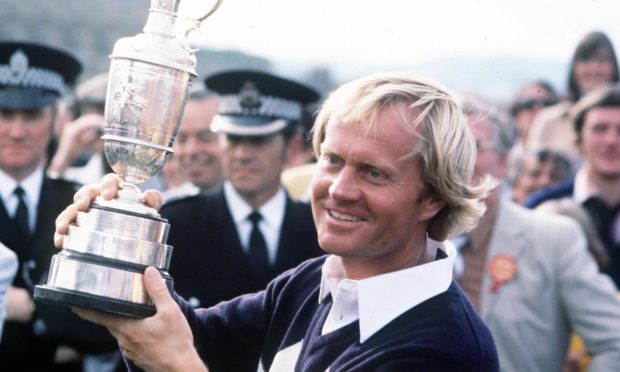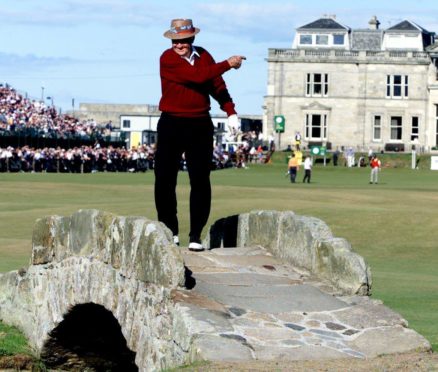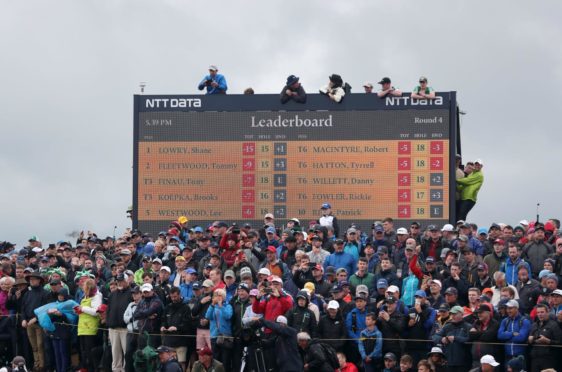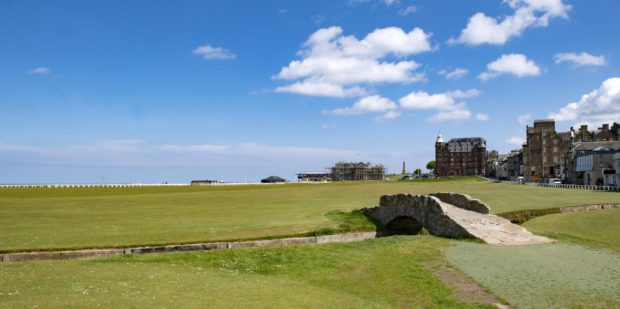If you’re the same vintage as me – and our research suggests you are – you probably recall this kind of scenario.
In July 1978, when I was 14, my Dad suggested we all go to final day of the Open Championship at St Andrews.
The night before.
So we drove over in the morning, paid for our parking in the fields nearby the course, paid whatever it was to get in – memory fails me, but I suspect it was a fiver or so – and got a sticker as proof of purchase.
We then spent the whole day tumbling over the dunes and straining over the Old Course’s impossible spectator sightlines to watch Jack Nicklaus – my Dad’s hero – win his third Open title.
Rocking up to see history made
We repeated this many times until, in 1989, I started to get in to the Open for free because I got this job. But it always seemed to me to be one of the glories that made the Open utterly unlike any other sporting event. You could rock up on the day and see history made.
Right up until 2018, believe or not, this was still a way of getting into the Open.
At Carnoustie that year, I was strolling the dunes on the Saturday and stopped for a cooling beer – you’ll remember how hot it was that summer – which probably cost more than the entry ticket did in 1978.
Behind me in the queue was a young man from Yorkshire, and we started chatting. The crew of he and his pals had left Leeds at 4 am that morning to drive up to Carnoustie.
He didn’t have a pre-bought ticket, but he knew you didn’t need to. He paid his £85 at the gate and gloried in being there. “It’s the Open, isn’t it?” he reasoned. “You’ve just got to come.”
The 150th Open will be all-ticket
This tradition is now, inevitably but still sadly, gone. Last week, in announcing the ticket release for the 150th Open at St Andrews next year, the R&A confirmed that all sales were in advance.
Indeed, you have to register with them online to be in a ballot for single day tickets, which opens in July.
The first all-ticket, pay-in-advance Open was the 2019 version at Royal Portrush, and simply to restrict safe spectator numbers. Have it open to all, they correctly reasoned, all of Ireland might have shown up.
The R&A quietly repeated the trick at Sandwich, which was rendered moot by the pandemic anyway. But this was clearly the way forward.
The R&A had much more knowledge who was buying tickets and how to communicate with the Open’s audience. They also found restricting ticket sales created a market and actually increased demand.
Portrush proved it. It still produced the second highest crowd ever at the Open, just trailing the 2000 championship at St Andrews. Sales of food, drink and merchandising went through the roof.
Open’s growth more achievable through advance sales
The R&A need to maximise the Open’s earning potential for the good works they want to do in golf throughout the world. They want a total of 200,000 at every Open, even the venues like Troon, Carnoustie or Muirfield who have never got close to that figure before. These things are achievable by going to advance sales.
And as one R&A suit pointed out to me last week, knowledge of the audience through advanced sales was crucial to communicating cancellation and then the expected restricted numbers next month at Sandwich for the 149th Open.
Furthermore, the 150th Open is history in the making. In the old way the R&A wouldn’t know how many would be coming. 250,000? More?
Watching an Open live at the Old Course has been a bit of a trial when it’s been 230,000 for the week. The Open at St Andrews – and in the town itself – was reaching breaking point.
I get all this. It’s the way of the modern world, it’s progress, and the R&A had to do it.
It’s probably a small thing to many, but it was a great treasure to some like me. And sadly, it has gone for good.
Who WON’T try to drive the 18th now?
The marketing campaign for the 150th Open launched last week. I’d rather hoped they’d get the 149th out of the way first, but maybe that’s just me.
Looking ahead, the way that the Old Course will be played next year, when half the field now bashes it miles, remains a concern.
Yes, weather can be a great leveller. 2015 was a case in point with light-hitting Zach Johnson winning. But given fair, calm conditions, who knows what the winning score could be.
Tom Watson last week reckoned 9th, 10th, 12th and possibly 16th were driveable by Bryson DeChambeau. If 16 is in range – downwind – then so are the third, sixth and seventh. The gargantuan Shell Bunker makes the last named a risk probably not worth taking.
Clearly the 18th is in range for most. We saw that at the weekend with the St Andrews Links Trophy, the first elite men’s event played on the Old Course since the pandemic.
Links trophy winner birdied the 18th all five times he played it
Winner Jack Cope birdied the hole five times – three times in regulation and twice in the four-hole play-off. His strategy was to drive the green every time. The final time, he had 20 foot putt for eagle – a birdie was suffice to win it.
If this is what the elite amateurs do, then you can imagine the pros will be similarly minded.
There’s probably nothing that can be done to 18, even if you really wanted to. The tee can’t be taken back any further. Altering any of the hole’s traditional specifications would absolutely be a sacrilegious step too far.
It’s just one hole. The risk-reward element has always been there – Jack Nicklaus tried on the 72nd hole of an Open as far back as 1970. But you could reasonably expect half the field to try driving it next year if the weather’s favourable.



